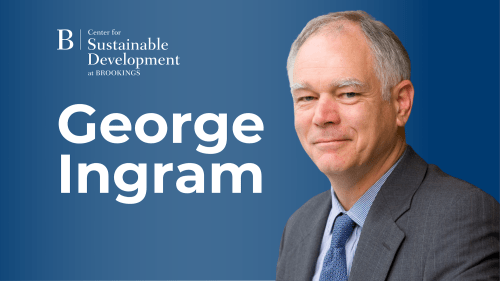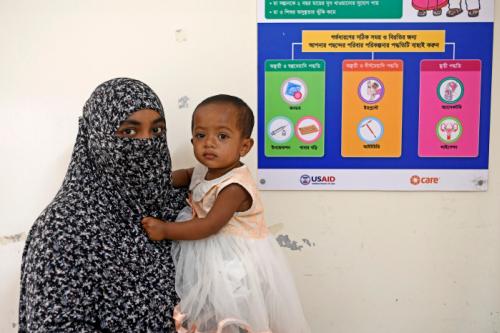Today USAID releases an interesting and informative report, “20 Years of USAID Economic Growth Assistance in Europe and Eurasia,” that will be the subject of a public forum at the Brookings Institution.
The report is valuable in documenting the U.S. contribution to this unique period of history—facilitating the transition of 29 countries from communism and statist economics—and highlighting lessons learned that may be relevant to current and future U.S. assistance policies.
About one-third of the American population has no living memory of the Cold War. The rest of us are quickly forgetting that we lived in a period dominated by the struggle between communism and capitalism/democracy as the major threat to world peace and stability. Faded from memory is that in the years immediately following the demise of Soviet control the countries of Eastern Europe and the former Soviet Union were fraught with economic turmoil and decline, threat of starvation, mass loss of jobs and income, disruption of social services (formerly provided by now bankrupt state enterprises) and inflation at dangerous levels.
We forget, or never knew, about the sizeable U.S. contribution, alongside the work of other bilateral donors and international agencies, to massive privatization programs, creation of central banks and regulatory regimes, changing the mentality of the banking industry from a provider of credit as allocated by state five-year plans to actually performing risk and credit analysis, helping write commercial code, creating tax regimes and introducing procedures for transparency and accountability of public utilities.
The report documents the contribution of USAID to this economic transition, relatively quick and successful in some countries, drawn out in others and still very much in play and without a clear end game in the less successful countries. It is a very substantive report with informative appendices. The report reminds us that we undertook in the 1990s an assistance program that rivals the Marshall Plan in its impact on the “other half of Europe” and the world in which we live.
With the focus the last several years at USAID on innovation, what is striking in reading the report is the extent of innovation that accompanied E&E’s programs in Europe and Eurasia. Maybe innovation is not actually new to the agency! Some of this innovation has been carried to other USAID programs; some has not. It is worth identifying some of these innovations:
Graduation—Assistance to the countries of Europe and Eurasia began with the assumption that the transition would be relatively short in duration and so the countries would be graduated from assistance—a novel concept in U.S. assistance programs. E&E developed a methodology—Monitoring Country Progress—that served as an annual assessment of how each country was progressing on key indicators that would help inform the decision as to when a country was ready for graduation.
Private Sector—USAID had been involved in a number of countries in promoting the private sector, but never to the extent as in this region—essentially helping to build private enterprise from scratch. The Europe & Eurasia (E&E) Bureau developed a comprehensive set of policies and programs to support private enterprise, both top-down and bottom-up—from helping to construct laws, policies and institutions that allow free enterprise to function; to creating a viable financial sector; to raising the competitiveness of specific business sectors; to working at the individual enterprise level. The assistance ranged from embedding technical advisers with government agencies, to refocusing economics education and creating business schools, to building business centers, to hands-on volunteer business exchanges.
Enterprise Funds—One of the innovative tools for building the private sector was the enterprise fund. U.S. assistance had been used in the past to finance public and agricultural infrastructure, to provide technical advice to business, to train business people and to guaranty bank lending and mortgage markets, but U.S. funds had never before been used to finance a venture fund that would put equity capital into specific business enterprises. The enterprise fund model sought to transfer American experience and knowledge of equity finance by bringing U.S. financial experts to the leadership of U.S.-funded venture funds that would train local experts and demonstrate by example this market mechanism. The 10 enterprise funds operating in 17 countries had a mixed record, of both success and failure. The report is accompanied by a very information separate appendix on the work of the enterprise funds. As this model has become a favorite of policy makers as part of the U.S. response to post-crisis opportunities, they would best familiarize themselves with the history and nature of this beast so they understand that it is not the B-all solution to enhancing the private sector and relevant only when there is an absence of indigenous equity finance and the macroeconomic environment is supportive.
Volunteers—Prior to 1990 USAID had engaged American volunteers in select programs in various countries, particularly in agriculture and business. But what happened with the opening up of Eastern Europe and the former Soviet Union was unprecedented and unexpected—thousands of Americans, some retired but many more not wanting to give up their gainful employment, wanted to be involved. Some were Diaspora from the region but more were just Americans who wanted to be part of this unique moment in history and make a contribution. A host of new volunteer organizations were created in response to the opportunity and demand. USAID deployed volunteers to contribute their experience and knowledge, mostly on a very personal, one-on-one basis. The volunteers represented all walks of professional life—financial experts (from private finance and state and federal regulatory agencies), businessmen and entrepreneurs, farmers, doctors and nurses, lawyers and judges, academic administrators and educators, members and staff of state legislatures, mayors and public administrators and experts in energy and public utilities. There was hardly a profession that did not send volunteers to help in the transition process. What was special about this volunteer involvement was not just the expertise that was conveyed, but the personal relations that were established—personal relations that often continued well beyond the specific task at hand and that helped change attitudes toward the country (the United States) that communism had deemed an evil empire.
Institution Building—Institution building has always been part of the USAID tool kit, both strengthening existing institutions and helping to establish new ones. But seldom has USAID operated in a part of the world that was nearly void of the normal government and private institutions essential to the functioning of a market economy and liberal democracy. The appendix to the report identifies over a hundred institutions that USAID, sometimes with engagement by other donors and agencies, was involved in helping to build, most of them from scratch. These institutions cover the range of public and private institutions—central banks, research and policy centers, business associations, stock markets, financial institutions, educational institutions and foundations. And this list does not include the many government ministries and agencies which USAID helped to strengthen and shift to a more market-oriented, transparent and accountable mode of operation. This amounts to a substantial legacy for USAID.
Technical expertise—USAID has always employed technical expertise. But the E&E Bureau early on became engaged in sectors in which USAID lacked in-depth knowledge, such as energy, banking, public utilities, stock markets, government regulation, pension funds and business management. Fortunately the Congress, in providing the legislative authority and appropriations for the assistance, understood the uncertainty of the transition process and provided a “not-with-standing” authority that granted the bureau the flexibility of not following the requirements of other assistance statutes, and the authority to use program funds to hire technical experts. Unlike other USAID bureaus, the E&E Bureau was staffed both with permanent career USAID employees and temporary (up to five years) contract personnel. The combination has worked well for the bureau, joining AID careerists well versed in development and AID procedures with highly skilled experts who can design and manage programs requiring detailed technical expertise.
Training and Exchanges—USAID has a rich history of engaging host country nationals in training and education programs. Those programs tailed off in the 1970’s. They were briefly revived for Central America during the U.S. policy focus on that region in the 1980s. They were again revived in the 1990s with our assistance to Eastern Europe and the former Soviet Union. This time some of the training was done in-country and in the region, not just in the U.S., and thousands of professionals were brought to the U.S., particularly business people, to spend several weeks in companies and other organizations to learn more contemporary modes of operations, much like in the Marshall Plan. Like the volunteer programs, the result was not just exposure to western concepts and ways of operating, but also to western values and the creation of sustained relationships.
Quick Response—Given the flexible authority provided by the Congress and the uncertainty of the transition process, the E&E Bureau (and its predecessor office) created nimble, quick response mechanisms that facilitated deploying experts and jump-starting programs and with the ability to make adjustments as circumstances and need proved to be different than anticipated. As the report notes, there was considerable “learning-while-doing,” which was appropriate given USAID’s lack of experience in the region and in facilitating a transition from communism.
In retrospect, a key foundation for this innovation and flexibility was a common understanding between the Executive Branch and the Congress on the basic purpose of the assistance, an understanding that successfully transitioned from the George H. Bush administration to the Clinton administration and then to the George W. Bush administration. The basis of this common view was the bipartisan authorizing legislation, the SEED Act (Central and Eastern Europe) and the FREEDOM Support Act (former Soviet Union).
The Executive Branch actually had no choice but to seek legislative authority, as section 620 of the Foreign Assistance Act of 1961 prohibits assistance to communist countries. With both the SEED and the FREEDOM Support acts, the administration sent modest proposals to the Congress and, on balance, got back better, more robust authority than it had proposed. And the common accord that was created by the process of enacting these two statutes created a strong foundation for the administration to implement the program with confidence of continued congressional support. This is an important lesson on the value of bringing the Congress on board in launching major foreign policy initiatives.
The Brookings Institution is committed to quality, independence, and impact.
We are supported by a diverse array of funders. In line with our values and policies, each Brookings publication represents the sole views of its author(s).



Commentary
Twenty Years of USAID Assistance to the Economic Transition of Eastern Europe and Eurasia — A Report from the USAID Europe and Eurasia Bureau
July 22, 2013